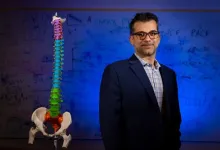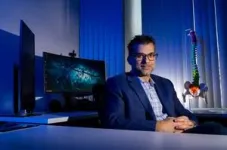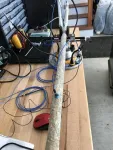(Press-News.org) With technology developed at UC Riverside, scientists can, for the first time, make high resolution images of the human spinal cord during surgery. The advancement could help bring real relief to millions suffering chronic back pain.
The technology, known as fUSI or functional ultrasound imaging, not only enables clinicians to see the spinal cord, but also enables them to map the cord’s response to various treatments in real time. A paper published today in the journal Neuron details how fUSI worked for six people undergoing electrical stimulation for chronic back pain treatment.
“The fUSI scanner is freely mobile across various settings and eliminates the requirement for the extensive infrastructure associated with classical neuroimaging techniques, such as functional magnetic resonance imaging (fMRI),” said Vasileios Christopoulos, assistant professor of bioengineering at UCR who helped develop the technology. “Additionally, it offers ten times the sensitivity for detecting neuroactivation compared to fMRI.”
Until now, it has been difficult to evaluate whether a back pain treatment is working since patients are under anesthesia and asleep. Thus, the patients cannot provide verbal feedback on their pain levels during treatment. “With ultrasound, we can monitor blood flow changes in the spinal cord induced by the electrical stimulation. This can be an indication that the treatment is working,” Christopoulos said.
The spinal cord is an “unfriendly area” for traditional imaging techniques due to significant motion artifacts, such as heart pulsation and breathing. “These movements introduce unwanted noise into the signal, making the spinal cord an unfavorable target for traditional neuroimaging techniques,” Christopoulos said.
By contrast, fUSI is less sensitive to motion artifacts. It emits sound waves into the area of interest, and red blood cells in that area echo the sound, producing a clear image. “It’s like submarine sonar, which uses sound to navigate and detect objects underwater,” Christopoulos said. “Based on the strength and speed of the echo, they can learn a lot about the objects nearby.”
Christopoulos partnered with the USC Neurorestoration Center at Keck Hospital to test the technology on six patients with chronic low back pain. These patients were already scheduled for the last-ditch pain surgery, as no other treatments, including drugs, had helped to ease their suffering.
For this surgery, clinicians stimulated the spinal cord with electrodes, in the hopes that the voltage would alleviate the patient’s discomfort and improve their quality of life.
“If you bump your hand, instinctively, you rub it. Rubbing increases blood flow, stimulates sensory nerves, and sends a signal to your brain that masks the pain,” Christopoulos said. “We believe spinal cord stimulation may work the same way, but we needed a way to view the activation of the spinal cord induced by the stimulation.”
The Neuron paper details how fUSI can detect blood flow changes at unprecedented levels of less than 1 millimeter per second. For comparison, fMRI is only able to detect changes of 2 centimeters per second.
“We have big arteries and smaller branches, the capillaries. They are extremely thin, penetrating your brain and spinal cord, and bringing oxygen places so they can survive,” Christopoulos said. “With fUSI, we can measure these tiny but critical changes in blood flow.”
Generally, this type of surgery has a 50% success rate. With improved monitoring of the blood flow changes, Christopoulos hopes this rate will increase dramatically. “We needed to know how fast the blood is flowing, how strong, and how long it takes for blood flow to get back to baseline after spinal stimulation. Now, we will have these answers,” Christopoulos said.
Moving forward, the researchers are also hoping to show that fUSI can help optimize treatments for patients who have lost bladder control due to spinal cord injury or age. “We may be able to modulate the spinal cord neurons to improve bladder control,” Christopoulos said.
“With less risk of damage than older methods, fUSI will enable more effective pain treatments that are optimized for individual patients,” Christopoulos said. “It is a very exciting development.”
END
Doctors can now watch spinal cord activity during surgery
New technology offers hope for treating chronic back pain
2024-03-07
ELSE PRESS RELEASES FROM THIS DATE:
Nanoscale CL thermometry with lanthanide-doped heavy-metal oxide in TEM
2024-03-07
A groundbreaking method for measuring the temperature of nanometer-sized samples within a transmission electron microscope (TEM) has been developed by Professor Oh-Hoon Kwon and his research team in the Department of Chemistry at UNIST. This innovative technology, utilizing nano-thermometers based on cathodoluminescence (CL) spectroscopy, opens up new possibilities for analyzing the thermodynamic properties of fine samples and advancing the development of high-tech materials.
The transmission electron microscope allows researchers to observe ...
Veteran PTSD fishing treatment project nets $1.3m in funding
2024-03-07
A “game-changing” $1.3m cash injection has been awarded to researchers exploring if doctors can prescribe fishing to treat PTSD.
The vital funding will allow the University of Essex’s Dr Nick Cooper and collaborator Dr Mark Wheeler to expand their influential work which has helped hundreds of military veterans.
Now the Department of Psychology’s Dr Cooper will explore if casting a rod from the bankside can aid police officers, paramedics, firefighters, and the coast guard deal with trauma.
Taking place over the course of three and a half years the National Institute for Health and Care Research-funded ...
Too few caregivers and too many patients – a bad combination for elderly in rural areas
2024-03-07
Ageing baby boomers are swelling the ranks of elderly across the Western world, with Norway no exception.
We know Norway's elderly population will increase, and it's likely there will be far fewer healthcare professionals to take care of them. The last 20 years has seen the population of Norwegians over the age of 80 increase by 40,000; the percentage of people aged 67-79 has grown by 37.9 per cent over the last 10 years.
Over the next 20 years, there will be 250,000 more Norwegians over the age of 80.
The ageing crisis has been predicted for ...
Earth’s earliest forest revealed in Somerset fossils
2024-03-07
The oldest fossilised forest known on Earth – dating from 390 million years ago – has been found in the high sandstone cliffs along the Devon and Somerset coast of South West England.
The fossils, discovered and identified by researchers from the Universities of Cambridge and Cardiff, are the oldest fossilised trees ever found in Britain, and the oldest known fossil forest on Earth. This fossil forest is roughly four million years older than the previous record holder, which was found in New York State.
The fossils were found near Minehead, on the south bank of the Bristol Channel, near what is now a Butlin’s holiday ...
European Lung Cancer Congress 2024
2024-03-07
Lugano, Switzerland, 07 March 2024 – The European Lung Cancer Congress 2024 is the annual appointment that brings together various experts in the field of thoracic oncology, including thoracic surgeons, respiratory physicians and pneumologists, medical and radiation oncologists, interventional radiologists and pathologists, to discuss the latest insights into the recent developments in the prevention, diagnosis and treatment of lung cancer.
The event will take place in Prague, Czech Republic, and through a dedicated ...
Pinging pipes could help to identify lead water lines without excavation
2024-03-07
As any percussionist or fidgety pen-tapper can tell you, different materials make different noises when you hit them. Researchers at Drexel University hope this foundational acoustic phenomenon could be the key to the speedy removal of lead water lines that have been poisoning water supplies throughout the country for decades. A recent study conducted with geotechnical engineering consultant Seaflower Consulting Services, showed that it is possible to discern a buried pipe’s composition by striking ...
A new manganese-fluorine catalyst with exceptional oxidizing power
2024-03-07
A research team, affiliated with UNIST has unveiled a cutting-edge catalyst with exceptional oxidizing power, capable of extracting electrons from compounds. Anticipated to revolutionize various fields, including the development of metal catalysts and synthetic chemistry, this catalyst marks a significant breakthrough in catalytic research.
Led by Professor Jaeheung Cho in the Department of Chemistry at UNIST, the research team successfully synthesized the pioneering manganese-fluorine catalyst, utilizing the Macrocyclic Pyridinophane System. This catalyst demonstrates the ability to induce oxidation reactions, ...
An aspirin a day? Poll of older adults suggests some who take it may be following outdated advice
2024-03-07
One in four older adults take aspirin at least three times a week, mostly in hopes of preventing heart attacks and strokes, a new poll shows.
But many people aged 50 to 80 who said they take aspirin may not need to, the findings from the University of Michigan National Poll on Healthy Aging suggest.
In all, 57% of people aged 50 to 80 who say they take aspirin regularly also said they don’t have a history of cardiovascular disease. Such people should have a conversation with their health care provider about what’s best for them before stopping or starting aspirin use.
National guidelines have changed in recent years for using aspirin for prevention, ...
What makes a pathogen antibiotic-resistant?
2024-03-07
Antimicrobial resistance is a story of constantly moving parts and players. With every new or tweaked antibiotic or antimicrobial drug, the targeted pathogens begin the evolutionary dance of acquiring resistance, prompting researchers to constantly develop workarounds or entirely new classes of medicine.
Understanding the underlying mechanisms of acquired antimicrobial resistance is critical to the fight, a case of knowing one’s enemy. In a new paper published March 2, 2024 in npj Antimicrobials and Resistance, part of the Nature Portfolio, researchers at Sanford Burnham Prebys, working with Roche Pharma Research and Early Development, ...
Method rapidly verifies that a robot will avoid collisions
2024-03-07
Before a robot can grab dishes off a shelf to set the table, it must ensure its gripper and arm won’t crash into anything and potentially shatter the fine china. As part of its motion planning process, a robot typically runs “safety check” algorithms that verify its trajectory is collision-free.
However, sometimes these algorithms generate false positives, claiming a trajectory is safe when the robot would actually collide with something. Other methods that can avoid false positives are typically too slow for robots in the real world.
Now, MIT researchers have developed a safety check technique which can prove with 100 percent accuracy ...
LAST 30 PRESS RELEASES:
Tracing the quick synthesis of an industrially important catalyst
New software sheds light on cancer’s hidden genetic networks
UT Health San Antonio awarded $3 million in CPRIT grants to bolster cancer research and prevention efforts in South Texas
Third symposium spotlights global challenge of new contaminants in China’s fight against pollution
From straw to soil harmony: International team reveals how biochar supercharges carbon-smart farming
Myeloma: How AI is redrawing the map of cancer care
Manhattan E. Charurat, Ph.D., MHS invested as the Homer and Martha Gudelsky Distinguished Professor in Medicine at the University of Maryland School of Medicine
Insilico Medicine’s Pharma.AI Q4 Winter Launch Recap: Revolutionizing drug discovery with cutting-edge AI innovations, accelerating the path to pharmaceutical superintelligence
Nanoplastics have diet-dependent impacts on digestive system health
Brain neuron death occurs throughout life and increases with age, a natural human protein drug may halt neuron death in Alzheimer’s disease
SPIE and CLP announce the recipients of the 2025 Advanced Photonics Young Innovator Award
Lessons from the Caldor Fire’s Christmas Valley ‘Miracle’
Ant societies rose by trading individual protection for collective power
Research reveals how ancient viral DNA shapes early embryonic development
A molecular gatekeeper that controls protein synthesis
New ‘cloaking device’ concept to shield sensitive tech from magnetic fields
Researchers show impact of mountain building and climate change on alpine biodiversity
Study models the transition from Neanderthals to modern humans in Europe
University of Phoenix College of Doctoral Studies releases white paper on AI-driven skilling to reduce burnout and restore worker autonomy
AIs fail at the game of visual “telephone”
The levers for a sustainable food system
Potential changes in US homelessness by ending federal support for housing first programs
Vulnerability of large language models to prompt injection when providing medical advice
Researchers develop new system for high-energy-density, long-life, multi-electron transfer bromine-based flow batteries
Ending federal support for housing first programs could increase U.S. homelessness by 5% in one year, new JAMA study finds
New research uncovers molecular ‘safety switch’ shielding cancers from immune attack
Bacteria resisting viral infection can still sink carbon to ocean floor
Younger biological age may increase depression risk in older women during COVID-19
Bharat Innovates 2026 National Basecamp Showcases India’s Most Promising Deep-Tech Ventures
Here’s what determines whether your income level rises or falls
[Press-News.org] Doctors can now watch spinal cord activity during surgeryNew technology offers hope for treating chronic back pain







